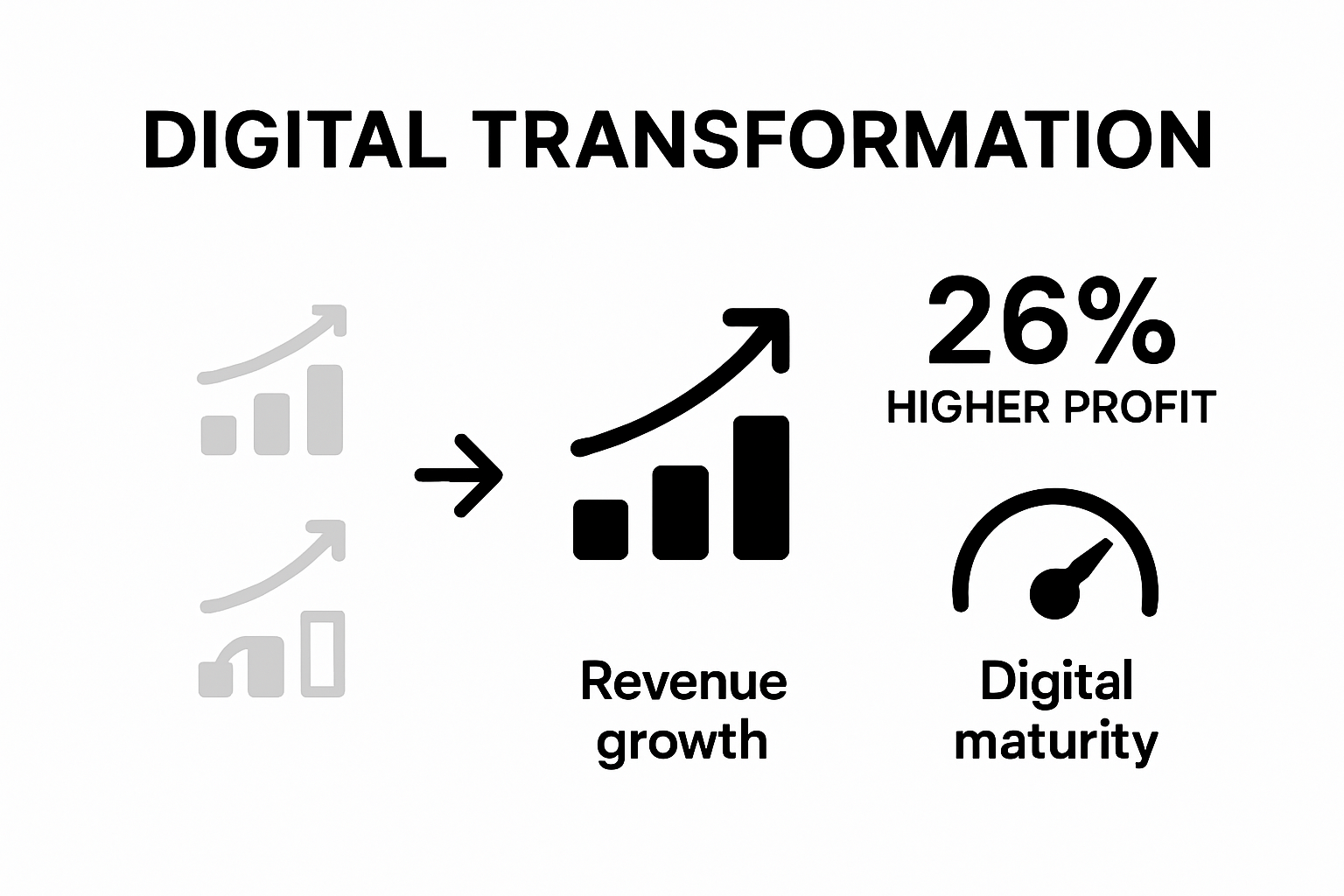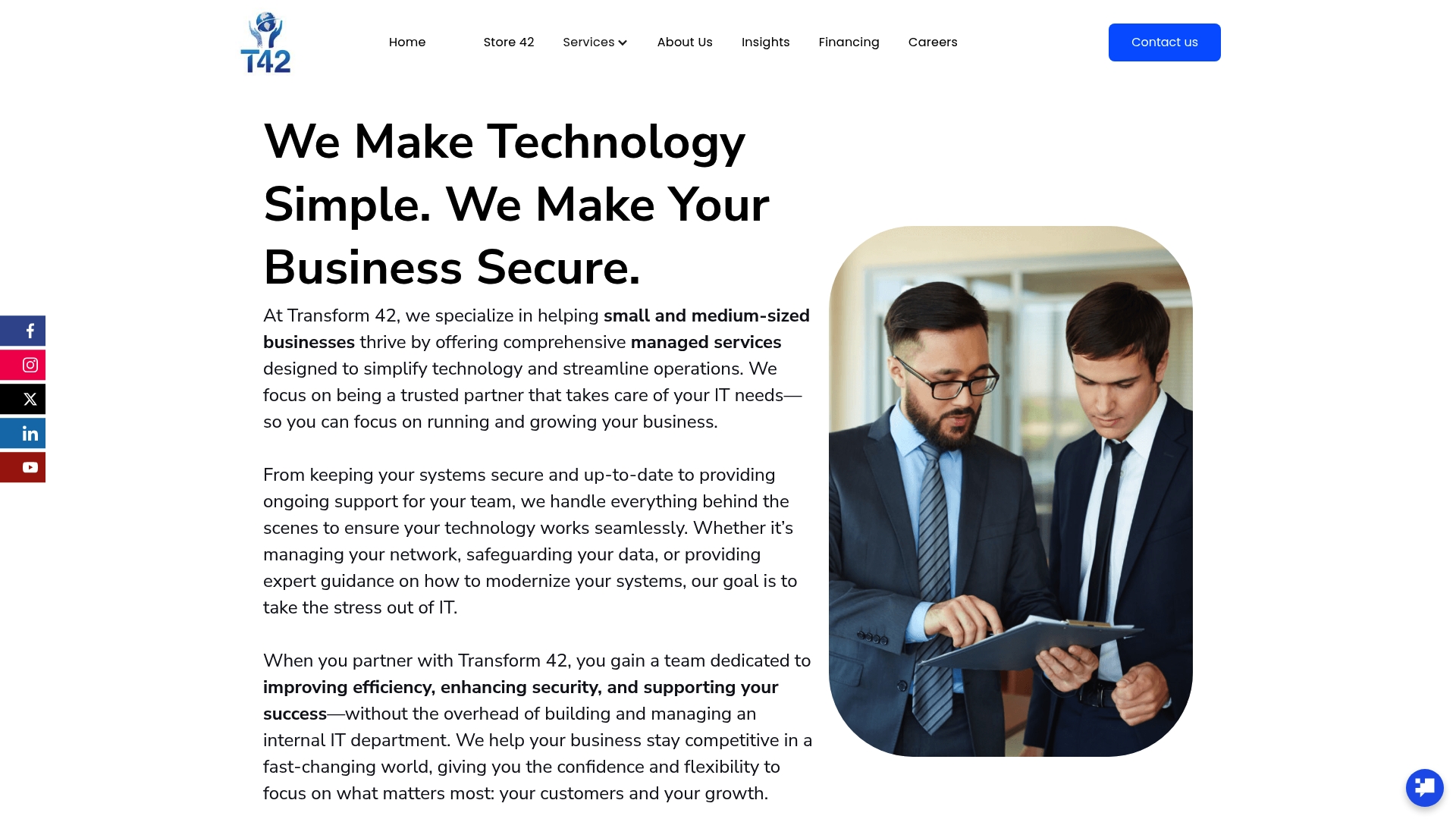
Digital transformation sounds like just another tech buzzword, but it is changing the rules for every business. Companies that jump on board with digital strategies are 26 percent more profitable than those clinging to old school methods. Most people think new software is the main driver behind this success, yet it is actually the entire mindset shift inside organizations that sparks real growth.
TakeawayExplanationDigital transformation is essential for survival.Businesses must embrace digital strategies to remain competitive and avoid obsolescence.AI and machine learning are key drivers.Implementing these technologies enhances efficiency and drives innovation in organizations.Focus on both technology and culture.Successful transformation requires investing in both technological tools and workforce adaptability.Small businesses need targeted strategies.Tailored digital strategies can help smaller organizations improve efficiency and engage customers effectively.Governance frameworks must evolve.As technology integrates more deeply, robust governance and ethical considerations become critical for organizations.
Digital transformation represents a comprehensive strategy where organizations fundamentally reimagine their core business processes, customer experiences, and operational models through strategic technology integration. This profound shift goes beyond simply adopting new technologies.
At its core, digital transformation involves systematically replacing manual, analog, or legacy systems with advanced digital technologies that enhance efficiency, productivity, and innovation. According to McKinsey, this process fundamentally changes how businesses operate and deliver value to customers.
Key characteristics of digital transformation include:
Digital transformation is no longer optional but a critical survival strategy for businesses in the 21st century. Organizations that successfully implement digital transformation can achieve significant competitive advantages by:

Why Businesses Cannot Ignore Digital Transformation
The global business landscape is rapidly evolving, driven by technological disruption and changing consumer expectations. Companies that resist digital transformation risk becoming obsolete. Research from the OECD demonstrates that organizations embracing digital strategies are 26% more profitable and generate significantly higher revenue compared to their less digitally mature competitors.
Ultimately, digital transformation is about strategic reinvention. It requires leadership commitment, cultural adaptability, and a forward thinking approach to technology integration that transforms how businesses create, deliver, and capture value in an increasingly digital world.
The trajectory of digital transformation is shaped by powerful technological and strategic forces that are fundamentally reshaping how businesses operate, innovate, and compete in an increasingly digital ecosystem.
Advanced technologies are driving unprecedented transformation across industries. According to the Open University, emerging technologies are catalyzing fundamental shifts in organizational capabilities and strategic approaches.
Key technological drivers include:
Businesses are no longer viewing digital transformation as optional but as a critical survival mechanism. Organizations recognize that technological adaptation is essential for maintaining competitive advantage, improving operational efficiency, and meeting evolving customer expectations.
Critical strategic drivers encompass:
Digital transformation extends beyond technological implementation into fundamental cultural and workforce reimagination. The human element remains paramount in successfully navigating technological transitions. Companies must invest in digital literacy, develop adaptive workforce skills, and create organizational cultures that embrace continuous learning and technological integration.
The most successful organizations will view digital transformation not as a technological project, but as a holistic strategic journey that integrates advanced technologies, human potential, and innovative organizational design. This approach ensures sustainable growth and meaningful technological integration that creates genuine value for businesses and their stakeholders.
Technology is evolving at an unprecedented pace, driving profound changes across industries and redefining how organizations operate, compete, and create value in an increasingly interconnected digital ecosystem.
Below is a table summarizing the main technologies shaping digital transformation in 2025 and their key applications as discussed in the article.
TechnologyKey Applications/ImpactArtificial Intelligence & Machine LearningAutomation, predictive analytics, personalized experiences, decision supportInternet of Things (IoT)Real-time data, remote operations, interconnected systems5G & Advanced ConnectivityEnhanced data processing, seamless integration, global communicationAdvanced Cloud ComputingScalable infrastructure, cost efficiency, operational agilityQuantum ComputingEmerging capabilities, complex problem-solvingImmersive Technologies (VR/AR)Training, interactive environments, user engagementEdge ComputingReal-time processing, decentralized infrastructure
Artificial Intelligence (AI) stands at the forefront of digital transformation, offering transformative capabilities that enable businesses to automate complex processes, generate predictive insights, and create more intelligent, responsive systems. According to the OECD, AI technologies are fundamentally reshaping strategic decision making and operational efficiency.
Key AI and machine learning applications include:
Connectivity technologies are breaking traditional boundaries, enabling seamless communication and data exchange across global networks. Internet of Things (IoT) and 5G networks are creating unprecedented opportunities for real time data processing, remote operations, and integrated technological ecosystems.
Transformative connectivity technologies encompass:
Digital transformation in 2025 will be characterized by technologies that create more immersive, intelligent, and adaptive user experiences. Virtual reality, augmented reality, and adaptive learning systems are pushing the boundaries of human computer interaction.
Immersive technologies represent a paradigm shift in how organizations engage with customers, train employees, and conceptualize complex systems. By creating dynamic, interactive environments, these technologies enable more intuitive, engaging, and effective technological solutions that transcend traditional interaction models.
Digital transformation represents a critical strategic imperative for small and medium businesses, offering unprecedented opportunities to reimagine operations, compete more effectively, and create sustainable growth strategies in an increasingly technology driven marketplace.
Small and medium businesses face unique challenges in digital transformation, requiring strategic and targeted technology adoption. Research from digital transformation studies demonstrates that businesses implementing comprehensive digital strategies can significantly enhance their market competitiveness and operational efficiency.
Key competitive advantages include:

Successful digital transformation goes beyond mere technology implementation. It requires developing a holistic approach that integrates technological tools, organizational culture, and strategic thinking. Small businesses must view digital transformation as a comprehensive journey of continuous learning and adaptation.
Critical innovation ecosystem components include:
Digital technologies enable small and medium businesses to optimize financial performance, streamline complex processes, and create more responsive organizational structures. By leveraging advanced technologies like cloud computing, artificial intelligence, and data analytics, businesses can unlock new levels of operational efficiency and strategic insight.
The most successful small businesses will approach digital transformation not as a technological project, but as a fundamental reimagination of how they create value, engage customers, and compete in an increasingly digital global marketplace.
The following table highlights the core areas where digital transformation impacts small and medium businesses, along with the associated benefits described in the guide.
Impact AreaKey Benefit/OutcomeCustomer EngagementImproved interaction and personalization, leading to higher satisfactionOperational EfficiencyStreamlined processes and cost savings through automationBusiness Model AgilityAbility to adapt quickly to changing market demandsFinancial PerformanceOptimization of costs and improved revenue generationInnovation EcosystemEncourages continuous learning and technological adaptationWorkforce SkillsDevelopment of digital literacy across all levels
Digital transformation is not merely a technological shift but a profound societal and economic reconfiguration that will fundamentally reshape how organizations, governments, and individuals interact with technology and each other.
Digital transformation is dramatically restructuring employment landscapes, creating new job categories while rendering others obsolete. According to the OECD Digital Economy Outlook, emerging technologies will necessitate continuous skill adaptation and lifelong learning strategies.
Key workforce transformation implications include:
As digital technologies become more pervasive, robust governance frameworks will become critical in managing their societal impact. Ethical considerations will move from peripheral discussions to central strategic planning across public and private sectors.
Critical governance focus areas encompass:
Digital transformation represents a fundamental reimagining of economic and social interactions. Technologies will enable more personalized, efficient, and interconnected systems that transcend traditional organizational and geographical boundaries.
The most profound impacts will emerge from the complex interactions between technological capabilities and human adaptability. Organizations and societies that develop flexible, inclusive, and forward thinking approaches to technological integration will be best positioned to thrive in the emerging digital ecosystem. Success will depend not just on technological adoption, but on creating meaningful human centered technological solutions that enhance collective capabilities and address emerging global challenges.
If you have learned from this article that digital transformation is more than just a technology upgrade, but feel overwhelmed by legacy systems, rapid tech changes, and the pressure to embrace strategic innovation, you are not alone. Many small and mid-sized businesses struggle with integrating AI, automating operations, and keeping pace with evolving customer demands. These challenges, highlighted in “Understanding Digital Transformation Trends 2025,” require a holistic approach that balances new technologies with cultural change and data-driven decision making.

Do not let uncertainty slow your growth. At Transform 42 Inc., we specialize in guiding businesses through the next wave of transformation. Our team will help you move beyond outdated processes, build an adaptive digital strategy, and implement IT solutions that support your goals. Learn how our IT-as-a-Service solutions make digital reinvention approachable and effective for every stage of your company’s journey. Visit our main website now to connect with experts who understand your industry and can help you seize the best opportunities before your competitors do.
Digital transformation is a comprehensive strategy that reimagines core business processes, customer experiences, and operational models through strategic technology integration. It involves replacing manual and legacy systems with advanced digital technologies to enhance efficiency, productivity, and innovation.
Digital transformation is crucial for modern businesses as it improves operational efficiency, enables data-driven decision making, and enhances customer engagement. Organizations that embrace digital transformation can gain a competitive advantage and better respond to market changes and technological trends.
Key technologies driving digital transformation include Artificial Intelligence (AI), Internet of Things (IoT), advanced cloud computing, and immersive technologies like virtual and augmented reality. These technologies enhance communication, data processing, and user experiences across various industries.
Digital transformation offers small and medium businesses opportunities to enhance competitiveness, optimize operational efficiency, and adapt more quickly to market demands. Success in digital transformation requires a holistic approach encompassing technology adoption, cultural change, and continuous learning.